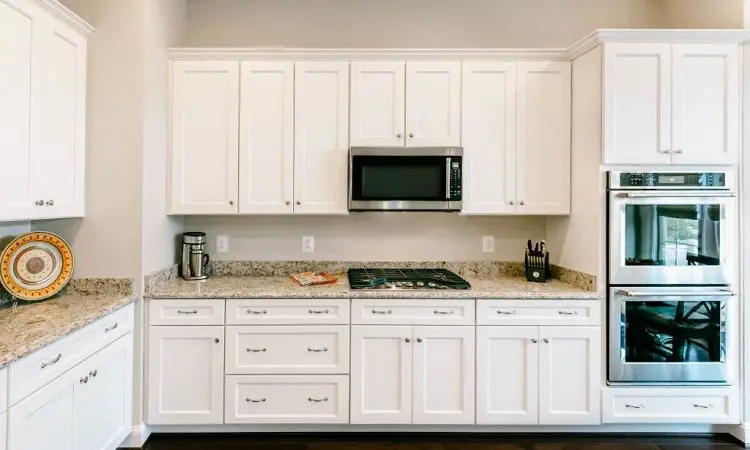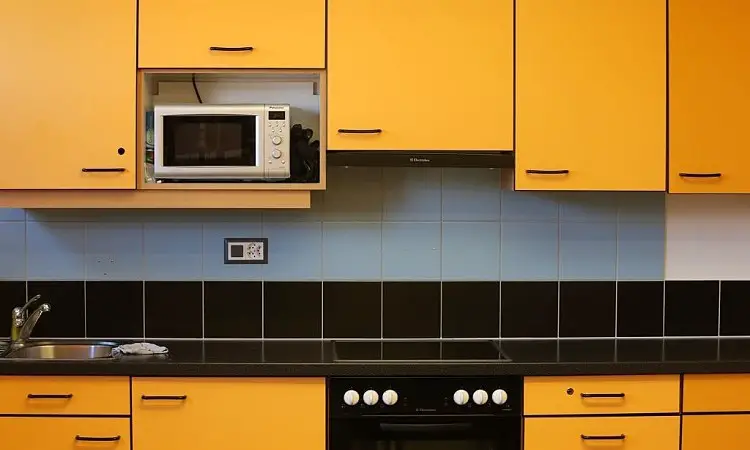You may want to put your microwave in a cabinet to save space in your kitchen area.
Although possible, there are some considerations before you can put a microwave in a cabinet.
Microwaves are specifically designed to be placed on kitchen countertops due to the built-in vents located at the back of the microwaves.
Placing in airtight spaces like a cabinet can block the vents and lead to overheating since the microwave cannot release steam from the microwave.
Here are some things you need to know if you’ve been wondering, can you put a microwave in a cabinet?
Can You Put a Microwave in a Cabinet?
A microwave oven can be placed in a cabinet.
Still, there are some important considerations to keep in mind for its safety, proper operations, and convenience.
Here are key factors to consider.
1. Ventilation
Microwaves generate heat and require good ventilation to avoid overheating and potential fire hazards in the kitchen.
Make sure the cabinet has enough airflow for the microwave to dissipate heat. Many built-in or built-in microwave ovens have specific ventilation requirements that must be met for safe installation.
2. Space and Size
Ensure the cabinet has enough space to accommodate the microwave and allow good air circulation.
Measure the dimensions of the microwave and cabinet to ensure a snug fit. Microwaves often require space around them to prevent overheating.
Check the manufacturer’s instructions for the recommended distances for the microwave’s sides, back, and top.
3. Power Sockets
Make sure that there is an accessible, properly grounded electrical outlet within the microwave’s reach.
4. Materials
Use heat-resistant, non-combustible materials for the cabinet and surrounding area to reduce fire risk.
5. Potential Weight
Ensure that the cabinet and any supporting structures can safely support the weight of the microwave.
6. Access
Consider how easy it is to access and use the microwave when it is installed in the cabinet. Make sure the microwave door can be opened and closed comfortably.
7. Professional Pose
Due to potential safety hazards and technical considerations, you should consult a professional installer or contractor who has experience installing the appliance and can ensure that the microwave oven is safe, installed correctly, and safely.
Before attempting to install a microwave oven in a cabinet, carefully read the instructions provided in the oven’s manual and all installation instructions provided by the manufacturer.
It is best to consult a professional to ensure the installation is done safely and complies with all safety standards.
What Kind Of Microwaves Go Into A Cabinet?

Microwaves designed to be installed in cabinets are often referred to as built-in or under-cabinet microwaves.
These microwave ovens are specially designed for installation in cabinets or under counters.
Here are some key features of microwave ovens suitable for cabinet installation:
Finisher Compatibility:
Many built-in microwaves come with a trim kit, a decorative frame that helps the microwave blend perfectly with surrounding cabinets.
The decorative kit gives a finished look and covers all the gaps between the microwave and the cabinet.
Ventilation Requirements:
Built-in microwave ovens have specific ventilation requirements to ensure good heat dissipation and safe operation.
These microwaves may have built-in fans or vents that direct heat away from the microwave and into the surrounding space.
Instructions for Customs Procedures:
Built-in microwave ovens usually have a recommended clearance distance to be maintained around the sides, back, and top of the microwave oven.
These clearances help prevent overheating and ensure safe operation.
Dimensions:
Built-in microwave ovens are available in different sizes and dimensions. It is important to measure the available space in the cabinet and choose a microwave oven that fits comfortably.
Front panel:
Many built-in microwave ovens have a front panel for easy access and operation, especially when installed under the counter or in a cabinet.
Installation:
Installing a built-in microwave may require cabinet modifications, such as adjusting the rack or making holes in the microwave.
Professional installation is generally recommended to ensure the microwave oven is installed correctly and safely.
Before purchasing a built-in microwave to install in a cabinet, it’s important to carefully review your microwave’s specifications, installation requirements, and operating instructions.
Follow the manufacturer’s instructions and recommendations to ensure a successful and safe installation.
If in doubt, consider consulting a professional installer with experience installing equipment to ensure the procedure is carried out correctly.
What Sizes of Microwaves Fit Into A Cabinet?
Most microwaves have a standard size of about 30 inches in width, 17 inches in height, and 15 to 18 inches in depth when fully closed. Built-in microwave sizes also tend to fit standard cabinet sizes.
When browsing products, check out the cutout and product dimensions to help you find the right microwave oven for your existing cabinet.
When purchasing a tabletop microwave, it’s important to consider the available space and your meal needs. You can select from various sizes, from compact to extra-large, to ensure the best fit for your requirements.
The size of a microwave that can fit into a cabinet can vary depending on the space available, the specific design of the microwave, and any modifications you want to make to the cabinet.
Here are some sizes for built-in microwaves:
Small microwaves:
They are compact microwaves with a small footprint. They typically have a capacity of about 0.5 to 0.8 cubic feet. Small microwaves are suitable for limited storage spaces or for reheating small portions.
Medium microwaves:
A medium-sized microwave has a capacity of about 0.9 to 1.4 cubic feet. They strike a balance between space-saving and cooking capabilities, making them suitable for a variety of needs.
Large Microwave:
Larger built-in microwaves can have a capacity of 1.5 cubic feet or more. These microwaves are designed to cook large dishes and may require more cabinet space.
When choosing a microwave oven size for cabinet installation, consider the following steps:
Measure cabinet space:
Measure the space in the cabinet where you plan to install the microwave. Please consider the cabinet’s dimensions, including its width, height, and depth.
Finishing set:
If you use a trim kit, include its dimensions in your measurements.
The cutter kit can add width and height to the overall size of the microwave. It is important to note the specific models and brands of microwave ovens may have different dimensions and requirements.
Therefore, always consult the manufacturer’s specifications and installation instructions before purchasing.
In addition, proper installation is critical to safety and functionality, so if you are unsure about this procedure, you should seek professional advice.
How To Measure The Dimensions Of A Microwave
Measuring the dimensions of your microwave is an important step when considering a cabinet installation or determining its location in a particular space.
To accurately measure the size of your microwave, follow these steps:
Measure width:
Place a tape measure or ruler horizontally over the widest part of the microwave, usually from side to side. Take measurements in inches or centimeters. Record the width measurement.
Measure height:
Place the tape measure or ruler vertically from the bottom of the microwave to the highest point, usually the top of the control panel or handle. Take measurements in inches or centimeters.
Record the height measurements. Measure the depth from the front outer surface of the microwave to the back, including any protruding parts such as door handles or control panels.
Take measurements in inches or centimeters—record depth measurements.
Measure internal power(optional). If you want to know the cooking space inside the microwave, open the door.
Measure the width, height, and depth of the inner capacity. These measurements will help you determine your microwave’s cooking capacity.
If you’re going to use a pre-assembled trim, measure the size of the trim as well. This includes width, height, and depth. Remember that the size of the kit will affect the overall size of the microwave once installed.
When recording measurements, clearly label them and note whether they are in inches or centimeters. Recheck your measurements to ensure they are correct.
Other Space-Saving Ideas to Integrate a Microwave in Your Kitchen

1. Install a Microwave as a Drawer
For a sleek and discreet look, consider a drawer-style microwave that can be built into an island or installed below the countertop.
This type of microwave provides easy access, with ample landing space for food going in or coming out of the oven without taking up valuable counter space.
Its integrated appearance suits kitchens with limited counter space or island installations. Anyone can easily reach this oven without stretching or strain, regardless of height.
The advantages of a drawer-style microwave are that it provides easier access than countertop or over-the-range models while saving valuable counter space.
Additionally, this configuration is the safest option for all users, adding a high-end look to any kitchen.
It is important to note that drawer-style microwaves have a few drawbacks. They tend to be pricier than countertop models, and their installation options are more limited.
2. Mount a Microwave Over the Range
If your kitchen is limited in space, consider installing an over-the-range microwave.
This option integrates the microwave with upper cabinets and gives your kitchen a streamlined appearance by grouping the appliance with the range below.
While many over-the-range microwaves provide light and ventilation for the range below, it’s important to note that the ventilation may not be as effective as a dedicated range hood.
If you have a pro-style range or cooktop, you may need to invest in a separate range hood for proper ventilation.
Over-the-range microwaves have several advantages, such as saving space in the kitchen and serving as a suitable substitute for range hoods in most homes.
However, it’s important to remember that these units are more expensive than countertop models and may require professional installation.
It is important to note that accessing the microwave by reaching over a hot range or cooktop can pose a safety risk.
3. Trim the Microwave with a Trim Kit
If you want your microwave to blend seamlessly with your cabinetry, you can use a trim kit to fill the gaps.
You can purchase a trim kit from the oven manufacturer or another supplier to fit most microwaves.
The benefit of using a trim kit is that it will give your kitchen a custom look. However, remember that using a trim kit will increase costs and require additional installation expenses.
4. Integrate a Microwave with Other Appliances
It’s practical to group cooking appliances together in one area. So, placing the microwave with a wall oven or other appliances is advisable.
Selecting a trim kit that matches your other appliances would be best to ensure that the microwave blends in seamlessly.
On the positive side, this solution saves countertop space. However, it requires appliances that match and can be grouped properly with your microwave to achieve an attractive and practical look.
5. Recess a Microwave into a Wall
Depending on the layout of your kitchen, you could potentially integrate the microwave by carving out space from a closet, garage, or vacant area.
However, it’s wise to consult with a builder or remodeler beforehand to ensure that the wall’s structural integrity won’t be compromised and to add reinforcement if needed.
On the positive side, this method creates a sleek, customized appearance without taking up counter or cabinet space.
On the downside, it may require some demolition and construction work.
Read Also:
Frequently Asked Questions
What is The Difference Between Over-The-Range And Built-In Microwaves?
When it comes to microwaves, over-the-range models are typically installed above the stove or cooktop, as they often include a range hood and stove light.
On the other hand, built-in microwaves can be placed anywhere in your kitchen. You won’t need to change your kitchen’s layout if you need to replace your current microwave with a similar size and style.
Over-the-range microwaves can often be installed in the same spot as your range hood. If you’re in the market for a new microwave, KitchenAid offers a variety of microwave hood combinations to choose from.
What is The Difference Between A Countertop Microwave And Built-In Microwave?
Regarding microwaves, the key distinction between countertops and built-in models lies in their installation.
Countertop microwaves are placed on the kitchen counter and can be used by simply plugging them into an outlet.
On the other hand, built-in microwaves are installed directly into the kitchen walls or cabinets.
Is A Built-In Microwave Worth It?
If you want a less cluttered kitchen counter, you might want to think about getting a built-in microwave. This option allows you to free up space on your countertop and have more room to create.
If you have a small kitchen with limited cabinet space or live in a rented unit where remodeling is not an option, a built-in microwave might not suit you.
Does A Built-In Microwave Need Ventilation?
Proper ventilation is necessary for built-in microwaves. The recommended cabinet depth for ventilation may differ for each model but generally falls between 15 to 22 inches.
If you’re unsure which microwave to purchase for your kitchen, check out this comprehensive microwave buying guide.
It covers various features and factors to consider when selecting a microwave.
Is There Anywhere You Should Never Store A Microwave?
Storing a microwave in front of a window is not recommended. Although the window may offer ventilation, the heat emitted by the microwave can potentially harm or break the window.
Additionally, if a fire occurs, having the microwave obstructing the window can pose a safety issue if the window is required to escape from the kitchen.
Conclusion
Hopefully, this article has given in-depth discussion to answer the question, “Can you put a microwave in a cabinet”?
If you’re wondering whether you can put a microwave in a cabinet, you could want to save space or just for aesthetics.
Whatever the case, you must remember that your microwave needs space to release the steam from it and use the external air to cool the vents. Blocking these vents can be catastrophic.

